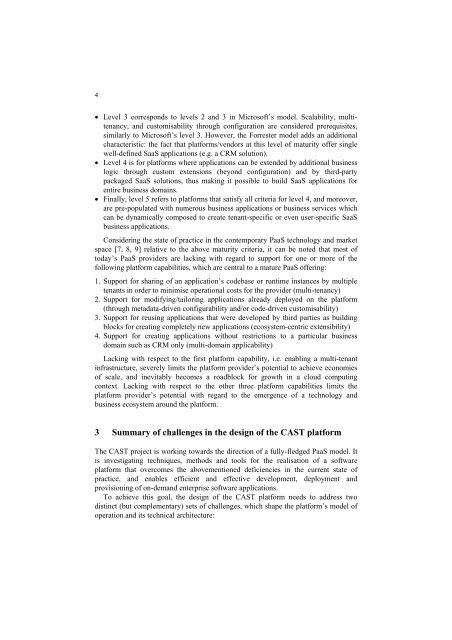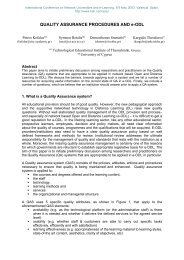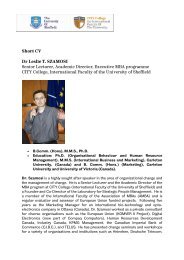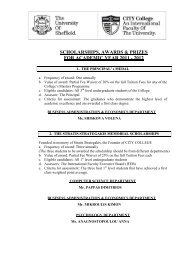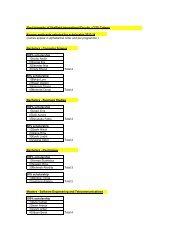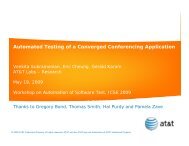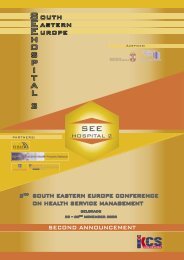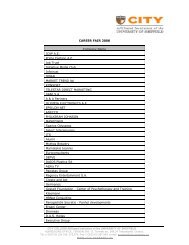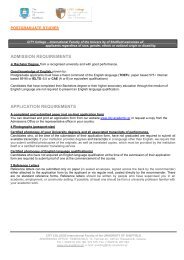Optimising development and deployment of ... - ResearchGate
Optimising development and deployment of ... - ResearchGate
Optimising development and deployment of ... - ResearchGate
Create successful ePaper yourself
Turn your PDF publications into a flip-book with our unique Google optimized e-Paper software.
4<br />
• Level 3 corresponds to levels 2 <strong>and</strong> 3 in Micros<strong>of</strong>t’s model. Scalability, multitenancy,<br />
<strong>and</strong> customisability through configuration are considered prerequisites,<br />
similarly to Micros<strong>of</strong>t’s level 3. However, the Forrester model adds an additional<br />
characteristic: the fact that platforms/vendors at this level <strong>of</strong> maturity <strong>of</strong>fer single<br />
well-defined SaaS applications (e.g. a CRM solution).<br />
• Level 4 is for platforms where applications can be extended by additional business<br />
logic through custom extensions (beyond configuration) <strong>and</strong> by third-party<br />
packaged SaaS solutions, thus making it possible to build SaaS applications for<br />
entire business domains.<br />
• Finally, level 5 refers to platforms that satisfy all criteria for level 4, <strong>and</strong> moreover,<br />
are pre-populated with numerous business applications or business services which<br />
can be dynamically composed to create tenant-specific or even user-specific SaaS<br />
business applications.<br />
Considering the state <strong>of</strong> practice in the contemporary PaaS technology <strong>and</strong> market<br />
space [7, 8, 9] relative to the above maturity criteria, it can be noted that most <strong>of</strong><br />
today’s PaaS providers are lacking with regard to support for one or more <strong>of</strong> the<br />
following platform capabilities, which are central to a mature PaaS <strong>of</strong>fering:<br />
1. Support for sharing <strong>of</strong> an application’s codebase or runtime instances by multiple<br />
tenants in order to minimise operational costs for the provider (multi-tenancy)<br />
2. Support for modifying/tailoring applications already deployed on the platform<br />
(through metadata-driven configurability <strong>and</strong>/or code-driven customisability)<br />
3. Support for reusing applications that were developed by third parties as building<br />
blocks for creating completely new applications (ecosystem-centric extensibility)<br />
4. Support for creating applications without restrictions to a particular business<br />
domain such as CRM only (multi-domain applicability)<br />
Lacking with respect to the first platform capability, i.e. enabling a multi-tenant<br />
infrastructure, severely limits the platform provider’s potential to achieve economies<br />
<strong>of</strong> scale, <strong>and</strong> inevitably becomes a roadblock for growth in a cloud computing<br />
context. Lacking with respect to the other three platform capabilities limits the<br />
platform provider’s potential with regard to the emergence <strong>of</strong> a technology <strong>and</strong><br />
business ecosystem around the platform.<br />
3 Summary <strong>of</strong> challenges in the design <strong>of</strong> the CAST platform<br />
The CAST project is working towards the direction <strong>of</strong> a fully-fledged PaaS model. It<br />
is investigating techniques, methods <strong>and</strong> tools for the realisation <strong>of</strong> a s<strong>of</strong>tware<br />
platform that overcomes the abovementioned deficiencies in the current state <strong>of</strong><br />
practice, <strong>and</strong> enables efficient <strong>and</strong> effective <strong>development</strong>, <strong>deployment</strong> <strong>and</strong><br />
provisioning <strong>of</strong> on-dem<strong>and</strong> enterprise s<strong>of</strong>tware applications.<br />
To achieve this goal, the design <strong>of</strong> the CAST platform needs to address two<br />
distinct (but complementary) sets <strong>of</strong> challenges, which shape the platform’s model <strong>of</strong><br />
operation <strong>and</strong> its technical architecture:


